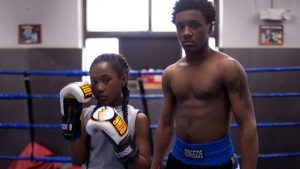
To call Toni (Royalty Hightower) a tomboy would be a bit of a misstatement. She’s a tomboy only because she’s grown up around masculinity, following her brother, Jermaine (De’Sean Minor), around like a puppy dog. She is grown accustomed to spending her time in the gym amongst boxers than engaging in “feminine” activities. The dance recitals across the hall catch her eye, yet she can’t get past the prying eyes of the dancers. They exist in a world in which she does not, and that lack of familiarity scares her.
That is the first of two refreshing approaches in Anna Rose Holmer’s direction. Developing the story with her fellow screenwriter, Saela Davis, the two tackle the outcast fitting into a foreign world with restraint and humanity. As opposed to having the world judge Toni, making her the prototypical underdog, the struggle comes from within. Toni’s greatest foe is herself. Her insecurities drive her to complacency, with the dance recital representing change in her life.

Change is a big theme in “The Fits.” It drives the titular fits, which are seizure-like symptoms befalling the dancers. At first it is believed to the rec center’s water supply, but that gets debunked quickly. It’s not hard to piece together the cause of the fits: it only occurs in young women, causing them temporary pain, then they return to normal. The girls are at first frightened, then fascinated by these fits, all of them wanting to experience it (sans Toni). These seizures act as symbolism, though having them occur in dangerous fashion overemphasizes their point. We get the point, though, and that’s all that matters.
The second refreshing approach is in how Holmer & Davis handle the relationships. Characters act more human, guided by their emotions than the mechanics of a script. Jermaine doesn’t look down at dancing, but encourages his sister to conquer her inner battle. The dancers don’t pick on Toni, only gazing at her as an anomaly. They’re quick to accept her, with her only hurdles being of her own diffidence.

This is a film about Toni finding herself, not about overcoming bullies. They’re not necessary in her world in order for her to overcome adversity. Her adversity is herself, which she slowly overcomes. As a loner, dancing brings out her gregariousness. She excels immediately at the dance routines when alone, but stumbles in her attempt at synchronization. She gets better the more comfortable she becomes around others.
A friendship blossoms with the outgoing Beezy (Alexis Neblett). She brings out the personality in Toni, in turn building her self-esteem. Up until this point, Toni was a restrained individual, always gazing blankly and being accompanied by ominous music (representing her feeling of dislocation). The score, direction, and tone change alongside Toni; the more outgoing she becomes, the more effervescent the film becomes.

Praise has been raining down on Royalty Hightower throughout the film’s festival circuit run and it’s all well-deserved. The young actress has the unenviable task of conveying isolation and growth, a hard task for any performer, let alone one making their debut. She pulls it off remarkably! This is one of those cases in which you feel like you’re watching the beginnings of a hot new prospect. It happened not too long ago with Angourie Rice in “The Nice Guys” and it happens here with Royalty Hightower.
“The Fits” moves along at a breezy pace. It clocks in at a paltry seventy-two minutes, which is a bonus refresher. This once again shows restraint in Holmer’s direction, not adhering to common runtimes by dragging her film out. The film is a brief outing, much like the briefness of the titular fits.
Final Rating: A-
